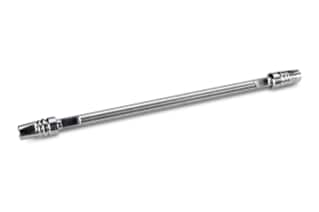
|
Chemistry |
C18 |
|
Separation Mode |
Reversed Phase |
|
Particle Substrate |
Silica |
|
pH Range Min |
2 pH |
|
pH Range Max |
8 pH |
|
Temperature Limits |
45 C |
|
Maximum Pressure |
18000 psi (1240 Bar) |
|
Endcapped |
Yes |
|
Bonding Technology |
T3 |
|
Silanol Activity |
Medium |
|
Particle Shape |
Spherical |
|
Particle Size |
2.5 µm |
|
Endfitting Type |
Parker-style |
|
Pore Size |
100 Å |
|
Format |
Column |
|
Surface Area |
230 |
|
System |
UPLC, UHPLC |
|
Particle Technology |
HSS |
|
USP Classification |
L1 |
|
Inner Diameter |
2.1 mm |
|
Length |
150 mm |
|
Carbon Load |
11 % |
|
eCord |
Yes |
|
UNSPSC |
41115709 |
|
Brand |
XSelect |
|
Product Type |
Columns |
|
Units per Package |
3 pk |

XSelect HSS T3 Column, 100Å, 2.5 µm, 2.1 mm X 150 mm, 3/pk
The HSS (High Strength Silica) Technology behind the XSelect HSS T3 Column was created by Waters to enhance the chromatographic performance of BEH (Ethylene Bridged Hybrid) and CSH (Charged Surface Hybrid) particles. The XSelect HSS T3 Column's incorporated HSS technology allows it to have higher silanophilicity, which aids in its ability to retain more polar compounds and exhibit dramatically different selectivity, both of which you will be able to see in your research. The columns are quite strong because to the High Strength Silica (HSS) technology, which was created to carry the mechanical strength required to deal with the UPLC pressures.
High transferability and outstanding reproducibility are two benefits of the XSelect HSS T3 Column. The XSelect HSS T3 Column is a special asset for your laboratory since it has the chemical and physical properties for easy scaling. The XSelect HSS T3 Column will give you the better resolution separations needed for complicated samples in order to separate and quantify the sample elements, thanks to its unique features. The XSelect HSS T3 Column's efficiency and selectivity enable you to obtain a good resolution of even extremely complex samples.
Trifunctional alkyl C18 bonded phase with ultra-low MS bleed and exceptional polar component retention is what is used in the HSS T3 sorbents. It is compatible with 100% aqueous mobile phase. Fully scalable and transferrable to UPLC separations are HSS T3 HPLC columns.
Having the appropriate lab equipment will help you work more productively. We advise looking through our website or catalog when looking to shop for lab equipment to make sure your needs are satisfied and to evaluate more Waters items that are compatible with the XSelect HSS T3 Column or other goods that you might be interested in.
Our Reversed-Phase QC Reference Material is a special collection of standards and mixtures that you might also want to take a look at. When doing difficult assays on a regular basis, it is appropriate and specifically made to give this complexity. It works with different column chemistries, sizes, and system hardware. It has a pH of 7 and is made up of seven different substances, including amitriptyline, propranolol, acenaphthene, butyl paraben, and uracil.
What Role Does Resolution Play in Chromatography?
Resolution in laboratory research is essential since the results may be utilized to optimize separations. Resolution is a function of peak width and retention time, both of which are fundamental characteristics of the chromatographic process.